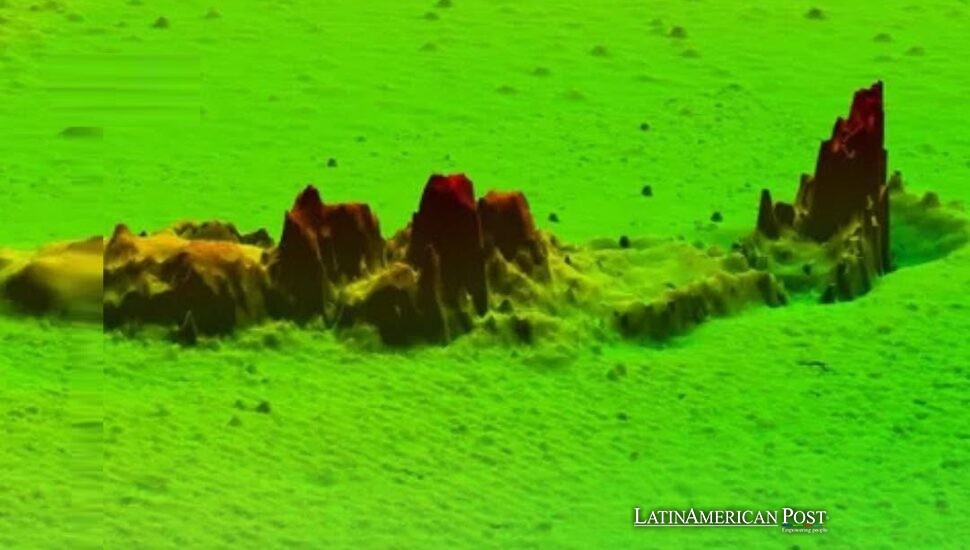Brazil Discovers WWII Shipwreck Unveils Unprecedented Underwater Images

More than 80 years after a Brazilian warship was torpedoed during World War II, naval researchers have confirmed the location of the sunken vessel “Vital de Oliveira.” Advanced imaging technology has revealed striking three-dimensional details of the wreck off Rio de Janeiro’s coast.
Historical Context and the Tragic Loss
On the night of July 19, 1944, amid the global turmoil of World War II, the Brazilian warship Vital de Oliveira met a tragic fate. As the conflict raged across oceans and continents, a German submarine launched a torpedo that struck the vessel along Brazil’s vast coastline. The attack claimed the lives of roughly 100 crew members out of an approximate complement of 270, marking the only instance during the war in which enemy forces sank a Brazilian military ship. Over the decades, this somber chapter of Brazil’s wartime history remained primarily confined to the annals of military records and the fading memories of survivors until recent efforts have brought the story back to life.
The Vital de Oliveira transported soldiers and supplies near Brazil’s coast. Its crew included teenage cabin boys who helped keep supply lines open in an important sea route for the nation. Nobody knew the ship’s final location for many years, which sparked interest from experts in history, archaeology, and naval studies. Many people offered ideas about where it sank, but no clear proof existed until recent events led a team to find it.
The sinking of Vital de Oliveira teaches us about sacrifices in World War II and shows how naval combat changed. A German U-boat attack proved that even protected ships faced serious risks from submarines below the surface. The strike changed how navies planned defense at sea after the war ended. Brazil is still working to understand this part of its past and its effects on military thinking. The ship’s discovery lets people study the tools and methods used in combat during those years. The wreck stands as a memorial to brave sailors who died and reminds us what war costs in human lives.
The Unlikely Discovery and Journey to Confirmation
The Vital de Oliveira’s rediscovery tale is as dramatic as its sinking. Over a decade ago, a seemingly routine catch by a local fisherman inadvertently set the wheels in motion. A fisherman pulled his net through the deep waters off Rio de Janeiro’s coast and hit an unexpected metal piece ‒ a part of an underwater relic. He did not know its value, but local maritime experts soon noticed.
A deep-sea diver who searched the same area later found something remarkable: the net had stuck to a large cannon that had fallen from a shipwreck. The Brazilian Navy started basic surveys after this find. However, the wreck’s identity stayed unknown for years because deep-sea research was difficult with the tools available then.
The work paid off when a research team started an in-depth study of the suspected site. The Brazilian Navy used a research ship named after the historic vessel to map the underwater area. They confirmed the hull’s location after careful planning and several tough trips. The Vital de Oliveira lay about 40 miles from Rio de Janeiro’s coast, as proven by exact surveys and data collection.
The find sparked new national pride and interest in history across Brazil. The discovery solved an old puzzle and showed how important sea history is. Many Brazilians see it as a mixed reminder of World War II losses that changed history’s path. The wreck’s confirmed spot lets historians, along with naval experts, study the whole vessel, which reveals new facts about naval tools and battle plans from that time.
Cutting-Edge Technology Reveals Unprecedented Details
The breakthrough in confirming the Vital de Oliveira’s location and condition would not have been possible without applying state-of-the-art underwater imaging technology. In recent years, advances in oceanographic instrumentation have revolutionized the field of marine archaeology, enabling researchers to explore depths and create detailed models of submerged structures with remarkable precision.
The Vital de Oliveira survey used multibeam echo sounders following to side-scan sonar systems. The echo sounder sent sound waves that reflected off the ocean floor, allowing researchers to create detailed three-dimensional models of the seabed. Clear images showed the ship’s hull shape or features that remained unseen for over 80 years.
The side-scan sonar created precise acoustic pictures of the wreck. The pictures offered a full view of the ship’s structure, from the cannon that caught the fisherman’s net to the specific damage patterns left by the torpedo hit. The unprecedented clarity of these images has allowed researchers to confirm the vessel’s identity beyond a reasonable doubt.
The data from these advanced systems creates precise 3-D reconstructions of the Vital de Oliveira. These models serve as tools for historians or archaeologists and let the public virtually explore this part of history. The detailed visualization of the wreck marks a key step in underwater archaeology and shows how modern technology changes historical research.
A set of plans includes technical dives and remotely operated underwater vehicles (ROVs). These tools capture detailed photographs or videos of the shipwreck and collect artifacts that remain on site. Brazilian researchers combine these methods to discover more about the ship’s build and the events surrounding its sinking. The research adds to our knowledge of the vessel and Brazil’s role in World War II.
The results from this tech-based research matter a lot. The 3-D models and visual records help experts rebuild past events more precisely to tell a fuller story of naval battles. The project shows the benefits of modern research methods in saving or studying historical items. The success of these methods proves Brazil’s scientific progress and dedication to preserving culture. This matters much for a country with deep sea-based traditions.
Legacy, Future Exploration, and Historical Significance
The confirmed location of the Vital de Oliveira, along with new images, changes how we view World War II and Brazil’s part in it. As Brazil’s only military ship lost to enemy fire in the war, the vessel represents an integral part of national memory. This discovery is valuable for archaeology or history but also honors those who died during that difficult time.
The shipwreck gives historians solid proof of past events. New detailed images or 3-D models show naval warfare methods used in World War II. A study of the ship’s build, torpedo damage, and final moments tells us about the ship’s design then and the battle choices made. This research also reveals how German submarines worked in the South Atlantic or what problems Allied ships faced near the coast.
The shipwreck adds value to culture and education. Brazilian museums plan to show these findings in exhibits and programs. These projects help people understand Brazil’s sea history or the war’s effects on the nation. Museums consider virtual displays or augmented reality to tell this story to young people.
The Vital de Oliveira’s discovery opens doors for more underwater research in Brazil. The Navy wants to search for other historic ships along the coast. Such work helps save history and teaches about sea safety, culture protection, and ocean care. Each wreck found adds detail to Brazil’s past.
A successful project to study the Vital de Oliveira marks progress in sea archaeology. Plans include more dives, artifact collection, and ship structure tests. Brazilian experts lead the way in historic exploration. The results will help scholars or guide decisions about cultural protection. These projects show that Brazil values its past but looks ahead.
This discovery sends a message to other nations. As technology helps us learn about history, the work on the Vital de Oliveira proves what research can do. The ship shows that old mysteries yield new methods. The project leads to additional searches in different places and valuable partnerships among nations to understand their shared history.
Also Read: Narco-Subs, Colombian High Seas and the $8 Billion Chase
A confirmation of Vital de Oliveira’s wreck marks a notable success for Brazil, a country with deep maritime ties. The first-ever photos from precise tools prove the work of past researchers or create paths to learn more. The researchers who study this sad but essential event help us remember those who died in World War II. The Vital de Oliveira’s tale stands as a guide for future sea discoveries.




